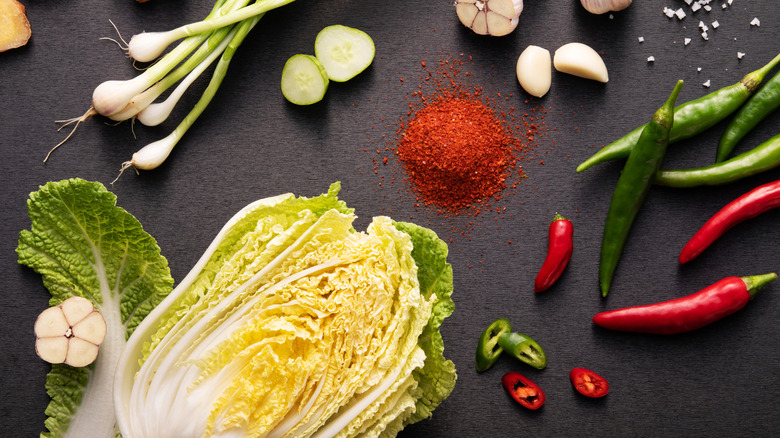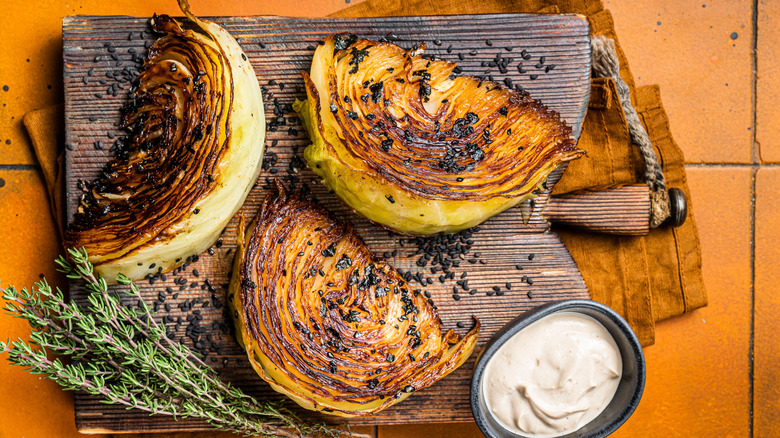The Best Way To Cook Cabbage To Make It Less Gassy
If you're a fan of cabbage but not its after-effects on your gut, you're not alone. While packed with vitamins and other vital nutrients, this versatile vegetable has a notorious reputation for causing gas. But before you cross it off your grocery list permanently, there are ways to prepare this cruciferous vegetable that won't leave you feeling bloated and flatulent, and you can keep your favorite cabbage dishes on your household menus. One culprit behind the discomfort is raffinose, a sugar that is not digestible by the enzymes in our bodies, producing gas when processed by our gut bacteria. This, combined with cabbage's high fiber content, means that this vegetable may require more effort from your digestive tract. The sulfuric compounds in cabbage also impart a distinct, unpleasant odor to the gas.
The good news is that there are many delicious ways to cook cabbage to soften the fibers and reduce the amount of sulfur, making this healthy vegetable easier to digest and more enjoyable to eat. Fermenting your cabbage into sauerkraut or a classic kimchi would be our number one recommendation to transform the vegetable from your gut's nemesis to an ally. This is because fermentation, unlike pickling, is a result of bacteria converting sugars into acid. The resulting acidic pH provides an optimum environment for certain gut-friendly probiotics to thrive, making fermented foods like kimchi and sauerkraut a great way to support digestive health while making you feel less gassy. Furthermore, longer fermentation times have been associated with reduced raffinose levels, minimizing the gassy aftereffects. However, there are other cooking methods that also make cabbage kinder to your tummy.
The universe of gut-friendly cabbage creations
The opportunities don't start and end with fermentation, because other culinary preparations can also work their wonders to transform cabbage from your gut's foe to a welcome friend. Cooking cabbage in general helps you reduce its gas-producing properties. Boiling cabbage helps break down the tough fibers, resulting in softer cabbage leaves that are gentler on your digestive system. Even steaming cabbage makes it easier on your digestive tract. You can add boiled cabbage to warming soups and stews, while steamed cabbage is perfect for flavorful Eastern European-inspired cabbage rolls.
Roasting cabbage enhances the flavor with a delectable, caramelized sweetness and imparts a mouthwatering char that can elevate cabbage to the main event of your dinner spread. The prolonged exposure to dry heat not only delivers a dish that's incredibly flavorful but also leaves you feeling less flatulent: a win-win. If you prefer roasted vegetables over steamed or boiled variations, roasted cabbage "steaks" might be the winner for you. Just avoid using napa cabbages for roasted preparations as their tender leaves are less likely to hold up and will fall apart during the process.
Stir-frying combines quick cooking with high heat, which softens the fibers while retaining a satisfying crispness. Incorporating gut-friendly spices like ginger further reduces the risk of gassy discomfort. A simple cabbage stir-fry with ginger, garlic, and colorful veggies with a protein of your choice makes for a complete, easy-to-digest meal. Whatever your preferred method, let heat be your friend in making your next cabbage preparation more enjoyable for your taste buds and your digestion.

